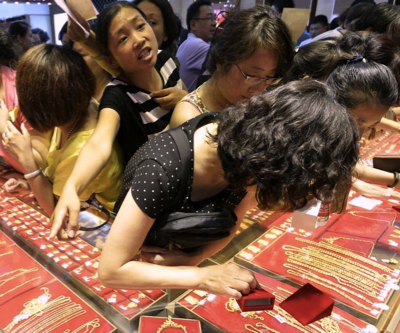
On Wednesday gold was drifting lower again with the February futures price down 0.5% or $5.40 from yesterday’s close at $1,068.70 in quiet noon trade on the Comex market in New York.
Gold struck its lowest level since October 2009 below $1,050 last week, after a hike in interest rates in the US which boosted the dollar and diminished gold’s attractiveness as an investment because it is not income-producing.
With the US rate hike out of the way gold bulls were hoping a switch of focus back to the fundamentals of the industry would boost the gold price, but adding to the metal’s woes are concerns about physical demand in its two largest markets, responsible from more than half of global demand.
In top consumer India gold demand for the December quarter could fall to 150 to 175 tonnes. That would be the lowest in eight years and compares to a 5-year average for the quarter of 231 tonnes, according to the World Gold Council.
The lack of demand is being blamed on a severe drought now in its second year that has hurt incomes for the country’s more than 50 million small scale farmers and depressed buying in rural areas which account for the bulk of India’s gold demand.
In the world’s second largest market for gold, prospects are not that great either albeit for totally different reasons. When gold entered a bear market following its September 2011 high, Chinese citizens began buying physical gold in droves, pushing the nation past India as the world’s largest gold consumer in 2013.
Much of the buying which totalled more than a 1,000 tonnes in 2013 were being done by so-called dama, a Chinese term for middle-aged women known for seeking out bargains. But with the metal continuing to set new lows and in its worst run since the late 1990s, dama buying dried up.
Then the slowing economy, the crash in on the Shanghai and Shenzen stock markets, and an anti-corruption drive by President Xi Jinping that hurt the Chinese practice of gift-giving to seal business relationships, gave more blows to the industry.
According to Reuters large retail chains, including the world’s largest jewellery chain Chow Tai Fook are closing branches in Hong Kong and Macau and slowing expansion on the Chinese mainland.
Chow Tai Fook last month reported a 42% fall in net profit in the first half of its financial year and said it would only open 60 stores in China for the year, down from a previous target of 150.
“Illustrating the strains in the industry, Chinese banks have begun to see loan defaults by jewellery manufacturers, hurt by weak sales,” Reuters reported last month.
Comments
Juan Manganelli
The only data you give is negative. Demand for december in India. Please make your “worries about Physical Demand in India and China” more objective by supplying the data for physical demand for India and China January to November 2014 and compare with 2015. Then i will worry about this demand. Difficult for me to find these figures It would not be for you as a Journalist for mining.com
Thanks for your help